Homologues - Study guides, Class notes & Summaries
Looking for the best study guides, study notes and summaries about Homologues? On this page you'll find 85 study documents about Homologues.
Page 4 out of 85 results
Sort by
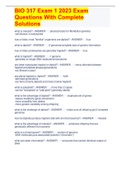
-
BIO 317 Exam 1 2023 Exam Questions With Complete Solutions
- Exam (elaborations) • 17 pages • 2023
-
Available in package deal
-
- $12.39
- + learn more
BIO 317 Exam 1 2023 Exam Questions With Complete Solutions what is meiosis? - ANSWER -physical basis for Mendelian genetics -cell division in eukaryotes true or false: most "familiar" organisms are diploid? - ANSWER true what is diploid? - ANSWER -2 genomes/complete sets of genetic information true or false: prokaryotes are generally haploid? - ANSWER true what is haploid? - ANSWER -1 genome -generally on single DNA molecule/chromosome are lower euk...
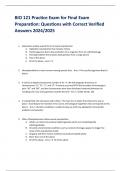
-
BIO 121 Practice Exam for Final Exam Preparation: Questions with Correct Verified Answers 2024/2025
- Exam (elaborations) • 44 pages • 2024
-
- $14.49
- + learn more
1. Eukaryotes employ several forms of sexual reproduction A. Vegetative reproduction that involves mitosis B. Parthenogenesis that is the production of an organism from an unfertilized egg C. Hermaphroditism that involves both gametes from a single parent D. Two of the above E. All of the above - AnsC 2. Hermaphroditism is most common among species that: - AnsAre sessile (organisms fixed in place) 3. A cell has a diploid chromosome number of 2n = 4. We will designate these four as ch...

-
Genetics-Exam 1 (ch 1-4) Questions with Verified Answers
- Exam (elaborations) • 12 pages • 2023
-
Available in package deal
-
- $10.49
- + learn more
What is genetics? - Answer- study of genes and what they do; branch of biology that deals with heredity and variation root of the natural diversity that we observe among members of the same species as well as among different species - Answer- Genetic variation Gene - Answer- "Unit of heredity", usually described according to the way it affects the traits or characteristics of an organism How many genes are there? - Answer- Around 30,000-35,000 How much of the genome is coded for? -...
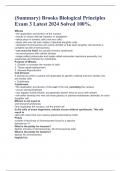
-
(Summary) Brooks Biological Principles Exam 3 Latest 2024 Solved 100%.
- Summary • 20 pages • 2024
- Available in package deal
-
- $14.49
- + learn more
(Summary) Brooks Biological Principles Exam 3 Latest 2024 Solved 100%. Mitosis • the duplication and division of the nucleus • results in clones with no variation or adaptation • takes place in somatic cells (non-sex cells) • starts with one cell and creates 2 identical daughter cells • replicated chromosomes are evenly divided so that each daughter cell receives a complete set (46 chromosomes) • can occur by itself, but usually involves cytokinesis • not synonymous with ...

-
(Summary) Brooks Biological Principles Exam 3 Latest 2024 Solved 100%.
- Summary • 20 pages • 2024
-
- $9.49
- + learn more
(Summary) Brooks Biological Principles Exam 3 Latest 2024 Solved 100%. Mitosis • the duplication and division of the nucleus • results in clones with no variation or adaptation • takes place in somatic cells (non-sex cells) • starts with one cell and creates 2 identical daughter cells • replicated chromosomes are evenly divided so that each daughter cell receives a complete set (46 chromosomes) • can occur by itself, but usually involves cytokinesis • not synonymous with ...
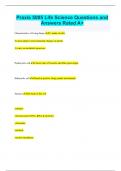
-
Praxis 5005 Life Science Questions and Answers Rated A+
- Exam (elaborations) • 15 pages • 2023
- Available in package deal
-
- $9.99
- + learn more
Praxis 5005 Life Science Questions and Answers Rated A+ Characteristics of living things 1) made of cells 2) must adapt to environmental changes or perish 3) carry on metabolic processes Prokaryotic cell consist only of bacteria and blue-green algae Eukaryotic cell found in protists, fungi, plants and animals Nucleus the brain of the cell contains: -chromosomes (DNA, RNA & proteins) -chromatin -nucleoli -nuclear membrane Ribosomes site of protein synthesis Endoplasmic reticulum vast system...
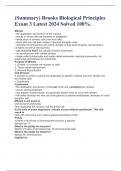
-
(Summary) Brooks Biological Principles Exam 3 Latest 2024 Solved 100%.
- Exam (elaborations) • 20 pages • 2024
-
- $14.59
- + learn more
(Summary) Brooks Biological Principles Exam 3 Latest 2024 Solved 100%. Mitosis • the duplication and division of the nucleus • results in clones with no variation or adaptation • takes place in somatic cells (non-sex cells) • starts with one cell and creates 2 identical daughter cells • replicated chromosomes are evenly divided so that each daughter cell receives a complete set (46 chromosomes) • can occur by itself, but usually involves cytokinesis • not synonymous with ...

-
MTTC Integrated Science Exam Questions With Verified Answers
- Exam (elaborations) • 32 pages • 2024
- Available in package deal
-
- $12.99
- + learn more
Independent Variable - Answer The experimental factor that is manipulated; the variable whose effect is being studied. Placed on the x-axis (horizontal) on a graph. Dependent Variable - Answer The variable that is measured in an experiment. Placed on the y-axis (vertical) on a graph. Scientific theory - Answer Must be repeatable. Possible to be disproved and capable of change. Sampling and Sample Size - Answer Random sampling is the preferred, but isn't always possible. A large sample ...
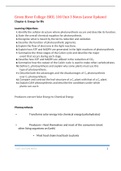
-
Green River College: BIOL 100 Unit 3 Notes Latest Updated,100% CORRECT
- Class notes • 116 pages • 2023
-
- $16.99
- 1x sold
- + learn more
Green River College: BIOL 100 Unit 3 Notes Latest Updated Chapter 6: Energy for life Learning Objectives: 1. Identify the cellular structure where photosynthesis occurs and describe its function. 2. State the overall chemical equation for photosynthesis. 3. Recognize what is meant by the terms reduction and oxidation. 4. Describe the function of photosynthetic pigments. 5. Explain the flow of electrons in the light reactions. 6. Explain how ATP and NADPH are generated in the light reac...
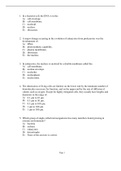
-
TESTBANK for Lehninger Principles of Biochemistry 7th Edition, Nelson
- Other • 647 pages • 2022
-
- $13.99
- 1x sold
- + learn more
Lehninger Principles of Biochemistry 7th Edition Nelson testbank 1. In a bacterial cell, the DNA is in the: A) cell envelope. B) cell membrane. C) nucleoid. D) nucleus. E) ribosomes. 2. A major change occurring in the evolution of eukaryotes from prokaryotes was the development of: A) DNA. B) photosynthetic capability. C) plasma membranes. D) ribosomes. E) the nucleus. 3. In eukaryotes, the nucleus is enclosed by a double membrane called the: A) cell membrane. B) nuclear envelo...

How did he do that? By selling his study resources on Stuvia. Try it yourself! Discover all about earning on Stuvia


